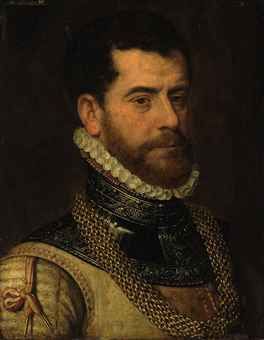Attributed to Frans Pourbus I (Bruges 1545-1581 Antwerp), Portrait of a gentleman, bust-length, in armor
Attributed to Frans Pourbus I (Bruges 1545-1581 Antwerp), Portrait of a gentleman, bust-length, in armor. Photo: Christie's Images Ltd., 2011
with the monogram of Don Gaspar de Haro y Guzmán, 'DGH' [with coronet] affixed to the reverse of the panel; oil on panel; 19 x 14¾ in. (48.2 x 37.4 cm.) - Estimate $30,000 - $50,000
PROPERTY OF THE HISPANIC SOCIETY OF AMERICA, NEW YORK, SOLD TO BENEFIT THE ACQUISITIONS FUND
Provenance: Don Gaspar de Haro y Guzmán, Marqués of Carpio and Eliche, Duke of Montoro, etc., Viceroy of Naples and Ambassador of Spain to the Holy See, Rome, according to the 1682 Roman inventory of his collection.
William Merritt Chase, New York.
Literature: Hispanic Society of America, Moro in the Collection of the Hispanic Society of America, New York, 1930, pl. III, as 'attributed to Moro'.
M. Burke and P. Cherry, Collections of Paintings in Madrid, 1601-1755, Los Angeles, 1997, I, p. 750, item [375].
Notes: While the identity of the sitter in the present portrait remains unknown, his ornately etched armored collar, or gorget, appears to be of Italian origin, datable to circa 1575-80. As Italian designs were immensely popular in the northern courts, it is quite possible that the confident gentleman portrayed here was from Flanders, where Frans Pourbus would have had the opportunity to capture his likeness. By the mid-seventeenth century, this painting found its way to Spain, where it was acquired by the infamous Don Gaspar de Haro y Guzmán (1629-1687), Marqués del Carpio, Marqués de Eliche, Duque de Montoro, Conde-Duque di Olivares and Conde de Morente, as evidenced by the presence of his monogram on the back of the panel.
Don Gaspar was one of the most important art collectors of his day. He was also a notorious womanizer, despite the fact that his wife was Doña Maria Antonia de la Cerda, a renowned beauty. A childhood friend of Balthasar Carlos, he was consequently part of Philip IV's intimate circle, especially after the prince's death in 1646. It may be said that Don Gaspar's passion for art led to his downfall in the Spanish court, as his relationship to the king was damaged irreparably after what Philip IV perceived as an unequal trade of works of art. Astonishingly, Don Gaspar retaliated against his newfound disfavor by attempting to blow up the Buen Retiro theatre and subsequently trying to murder his accomplice. His plan failed, and he was jailed for several years in 1676. Upon his release, he left Madrid to become Ambassador before the Holy See in Rome, where he became a patron of Carlo Maratta and Luca Giordano. His remaining years were spent in Naples, where, upon his death in 1687, his collection comprised over 3000 works. Many of his more important paintings are today housed in public collections, such as Velazquez's Rokeby Venus (London, National Gallery), Correggio's Madonna del Latte, (Budapest, Szépmüszeti Museum) and Raphael's Alba Madonna (Washington, D.C., National Gallery of Art).
The present painting may have been recorded in Don Gaspar's 1682 Roman inventory, taken as he was moving to Naples as Viceroy. The entry, published by Burke and Cherry (loc. cit.), reads: '[fol. 64v] 413 Un quadro che rappresenta un Ritratto di un huomo con collarina di armatura di mano di [blank] di palmi 2. et 1½ in circa con sua cornicia nera, et oro stimato in 12'. That the notary was unable to find a suitable attribution to this painting may attest to its Flemish origin.
Christie's. Old Master & 19th Century Paintings, Drawings & Watercolors Part I, 26 January 2011, New York, Rockefeller Plaza www.christies.com

/https%3A%2F%2Fprofilepics.canalblog.com%2Fprofilepics%2F1%2F0%2F100183.jpg)
/https%3A%2F%2Fstorage.canalblog.com%2F03%2F02%2F119589%2F96711876_o.jpg)
/https%3A%2F%2Fstorage.canalblog.com%2F11%2F31%2F119589%2F94773502_o.jpg)
/https%3A%2F%2Fstorage.canalblog.com%2F20%2F83%2F119589%2F94772815_o.jpg)
/https%3A%2F%2Fstorage.canalblog.com%2F26%2F72%2F119589%2F75604929_o.jpg)
/https%3A%2F%2Fstorage.canalblog.com%2F59%2F60%2F119589%2F26458628_o.jpg)



/http%3A%2F%2Fstorage.canalblog.com%2F25%2F84%2F119589%2F126904576_o.jpg)
/http%3A%2F%2Fstorage.canalblog.com%2F08%2F58%2F119589%2F112436483_o.jpg)
/http%3A%2F%2Fstorage.canalblog.com%2F40%2F36%2F119589%2F94686679_o.png)
/http%3A%2F%2Fstorage.canalblog.com%2F29%2F98%2F119589%2F93212137_o.jpg)